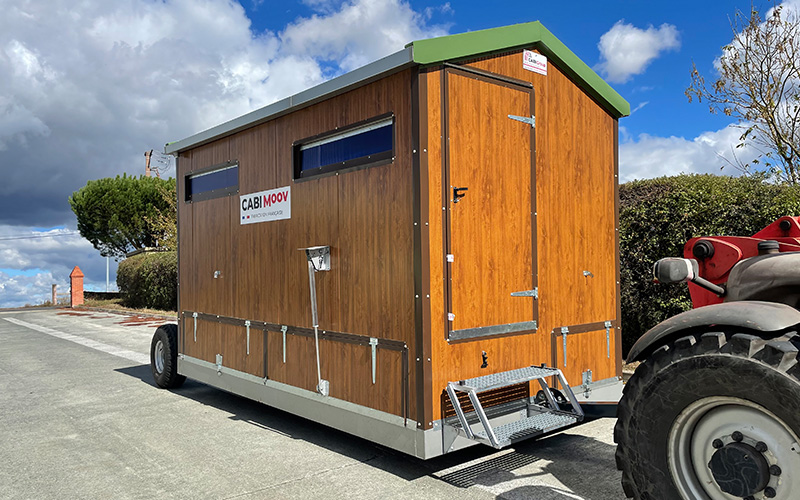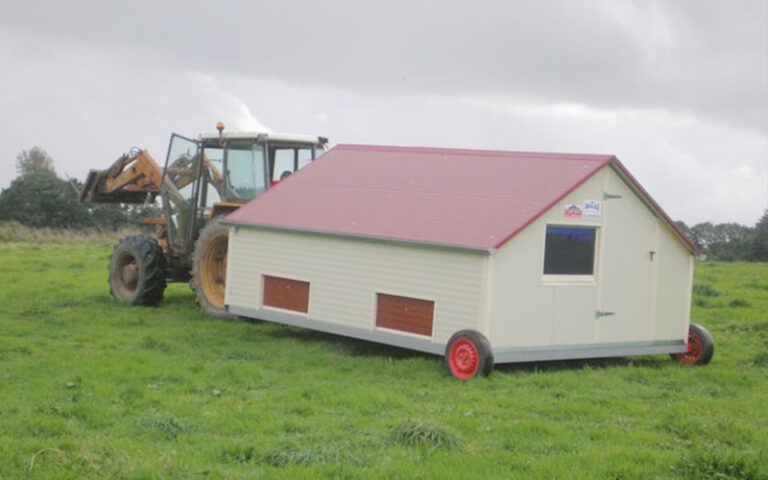Have you considered a mobile building? These small, lightweight installations are just as well suited to family or professional poultry farms. They’ve been springing up all over the place over the past ten years or so, and believe us, it’s not just a passing trend. You’ll see that there are many advantages and benefits to choosing a mobile hen house for your hens, turkeys or other poultry.
There are many organizations that promote mobile henhouses, testimony to the popularity of this type of building. Shall we go through the introductions?
Understanding what a mobile henhouse is
What is a mobile hehouse ?
The idea of making a fixed installation mobile is linked to the first free-range broiler farms, where chickens were reared on pasture. These hen houses have the particularity of adapting to their environment. They have no floor, except for certain small raised models, and are fitted with wheels. This means they can be moved easily from one part of the site to another.
The structure is therefore light enough for a tractor to transport it over a short distance. When it comes to living space, the range is vast. From very small up to 150m², there’s something for everyone.
The first mobile hen houses were developed in south-west France for free-range broiler rearing. The aim was to move the chickens to new runs for each new batch so that they could benefit from ideal rearing conditions.
In countries such as Germany, France and Switzerland, it has become quite common to find poultry farms equipped with mobile hen houses, and there are now thousands of them.
Manufacturers offer chassis-mounted or cattle-truck models, depending on the structure and size of the building. In terms of materials, sandwich panels are generally used for good insulation, and wood can also be used for cladding for aesthetic appeal. So, what are the differences with a ‘classic’ henhouse?
Differences between mobile and fixed hen houses
The main difference is the flexibility of location offered by the mobile henhouse. You no longer need to walk up and down your plot to decide on the best orientation, before starting work on the foundations.
With a mobile building, you can use the entire surface area for your poultry, alternating between areas reserved for living and areas for roaming. Guaranteed entertainment for your hens, and an excellent way of optimising the use of space on your land on the long run!This usually involves a movable fence too, unless you prefer to give your hens the same amount of space by simply moving the building within the plot. It’s a bit less fun when it comes to renewing the park’s vegetation, but why not?
Advantages of the mobile chicken coop:
- Provides living conditions that respect the hens’ needs;
- Preserves the environment.
- Reduces health risks
There’s a reason why they are so popular. Being able to modulate the location of a barn means reducing the risk of disease for the animals. As we know, the quality of the environment has a huge influence on the development of parasites such as coccidia. The more the air is renewed, and the more undesirables are directly exposed to climatic variations, the better protected your poultry is.
In the same way, the soil appreciates being able to replenish itself after housing several dozen animals for a few days or weeks. And if all the production factors are improved, it means that your poultry can give the best of themselves.
Finally, moving the hen house allows you to renew the hens’ runs.
In the case of broiler poultry, the hen house is generally moved to a new run when new chicks arrive. This reduces the time needed for a sanitary vacuum, as the new run is free of parasites. What’s more, the droppings remain on the ground, so it takes much less time to remove them, spread them around the plot or sell them than it does to remove them from a fixed building.
Avantages du poulailler fixe : Advantages of a fixed house:
- No work to move the structure ;
- Possibility of building a larger, more complex structure.
Depending on the nature of your project, and your ambitions, the mobile chicken coop may not be best option for your needs. Although, we’ve seen that there are structures larger than 150m². You can also choose to equip your farm with several of them, so that the size of your operation corresponds to regular, profitable production.
The benefits of a mobile henhouse
The advantages are great, but the benefits are even better! Let’s take a look at what it can do for your poultry and your farm.
Improved animal welfare
With access to new spaces, a varied diet and a playground that stimulates their natural foraging behaviour, your poultry will be delighted! Whether you have a quality label or not, your poultry will be all the better for it, and you’ll also be more peaceful as you watch them happily go about their day.
Positive impact on poultry health
Well-being also means good health. Don’t we say ‘a healthy mind in a sound body’? With a mobile home, you’re guaranteed to reduce the risk of illness. And that means lower vet bills, and we love that. We’ll bet you a box of eggs that you do too? All thanks to the rotation of the building’s location, which prevents parasites from having the chance to settle in.
Positive impact on egg quality
Healthy animals are also in a better position to produce good eggs and tasty meat. An American study of 14 farms showed that the quality of ‘pastured’ eggs was significantly higher than that of eggs from buildings. The independent laboratory that carried out the analyses found twice as much omega-3, 3 times as much vitamin E, an increase in beta-carotene and other vitamins.
Environmental benefits
The soil also needs to be healthy if it is to produce quality food. But in livestock farming, overuse of the land can sometimes compromise the sustainability of the resource.
But thanks to a sensible, well-distributed use of the different areas, you’ll benefit from regular and particularly productive fertilisation! What’s more, the chickens help to weed and aerate the soil, scratching around all day to find what they’re looking for. What more could you ask for than free labour?
A natural insecticide
Poultry collect worms and insect larvae. Why not take advantage of this opportunity to include poultry in your market gardening rotations to clean up residual vegetation and remove parts that will be sources of fungus development, and include them during periods of high pest pressure in orchards or vineyards.
Our advice before buying a mobile henhouse
Regulatory and administrative considerations
You’re clearly beginning to be convinced by mobile hen houses. But before you rush off to your supplier, take a look at the regulations. It would be a shame to make a faux pas and then find yourself in trouble in the middle of production. Find out all you can about your poultry farming project at local level. Perhaps there’s a local planning scheme in force?
Yes, even if there are no foundations, you still need to take the same precautions and carry out the same checks as for a permanent building. The obligation to apply for planning permission varies from country to country. In France, for example, it is compulsory from 20m2 upwards. And even if there is no particular limit to be respected between your buildings and the ends of your plot, think about your neighbours and any potential nuisance.
If in addition, you have chosen to run your little herd organically, or under another quality label, there are strict specifications to be complied with. In particular, there are loading criteria, with a few examples in the table below (these apply to UE farming):
For mobile henhouses | Laying hens | Broilers |
Conventional free-range |
|
|
Organic farming |
|
|
Planning the locations
Just because you know you’re going to be able to move your henhouse around, doesn’t mean you shouldn’t plan ahead. It’s best to have a map of future locations in mind (or even on paper). This will give you a good idea of the potential of the land and the resources available, depending on how you plan to use them. A bit like a rotational grazing plan.
There may be places on a slope, or less convenient to access, where you won’t be able to move the building. And if there’s a flood zone anywhere on the plot, think about that beforehand.
In any case, think in advance about how much time you’re going to have to devote to handling the building. If you don’t, you risk being caught short when it comes to organising your work.
Le CABI Origin en déplacement
How often do you need to move it? This depends on the capacity of your site and how you want to manage it. But don’t wait until you see it getting damaged before remembering to move it!
An analysis of the reduction in the level of embankment is a good indicator of the need to move. Of course, this depends on the weather conditions and the number of hens per m² on your run.
Note that, in theory, the surface area of the run is given over the lifetime of the birds, so the surface areas accumulate with each move.
Choosing the right model
We could have talked about this in the previous section because, obviously, choosing the right model is important before diving in head first. Before you get lost in all the references, ask yourself the following question: what are my needs?
Only then can you compare the features of the mobile hen houses on the market in relation to those needs. This is the basis for identifying the criteria you need for your project.
This is also where the question of budget comes in. It varies greatly depending on the dimensions, the materials used and whether or not it’s bought assembled.
We’re talking about a mobile henhouse here, and the structure needs to be robust enough to withstand being moved around several times during its lifetime, sometimes on unstable ground. So go for sturdiness, rather than incurring the expense of renewing, reinforcing or re-screwing the nuts and bolts after a few months.
What’s more, a well-built, solid henhouse can be sold even after several years.
If you choose the kit option, don’t panic, everything comes with detailed instructions. With two good friends and a 60m² building, it shouldn’t take you more than 3 hours to install everything. Fans of construction games are in for a treat!
Of course, the equipment you choose to fit can also add to the bill, but that’s an investment. Always think long-term when farming!
For example, integrating an automatic, solar-powered control system to manage lighting and the opening of exit hatches can save you precious time over the long term.
Finally, the size of the henhouse should be calculated according to a number of parameters, such as:
- The number of birds;
- The amount of land available;
- The motorised traction capacity adapted to the weight of the henhouse;
- The construction materials to ensure durability and ease of movement.
Using the mobile poultry house
Travel management
Are you there yet? Congratulations! Now, to ensure that moving around goes as smoothly as possible, do everything you can to spare your poultry any stress.
We assume that you have accustomed them to your presence. This is essential if you want the rotations to go as smoothly as possible and become a habit. Preferably choose the same time of day, so that it’s normal for them when this happens, just like when you come to feed them.
As a result, the tractor will be a formality, as will seeing their house move a few metres each week.
Maintenance and Safety
You’ll need to carry out regular cleaning and maintenance on your installation. Changing location doesn’t mean you don’t have to clean up after yourself. The walls of the building can be a breeding ground for infectious agents, so after the end of each batch, plan to leave the henhouse empty for a period of time to avoid proliferation.
The best building will not last if it is not well maintained. If this seems obvious to you, so much the better, but we felt it was important to point it out.
If your mobile hen house is equipped with a floor, opt for a design that will allow you to evacuate droppings easily without resorting to complex and more expensive solutions that will require more maintenance.
Intérieur d’un CABI Moov
Conclusion
The mobile henhouse is beginning to make a name for itself in poultry farming. From small family workshops to professional installations, there’s something for everyone. Yours could well benefit from its many advantages. Do you want to make the most of your land, while offering your hens, turkeys or ducks an incomparable quality of life? This type of building could well meet all your needs.
To be sure, all you need to do is contact your supplier to discuss your requirements. They’ll be able to advise you on the best choice to make your project a reality, taking into account your constraints and desires. Your poultry will be extremely well looked after, and there’s every chance they’ll be the envy of many!












